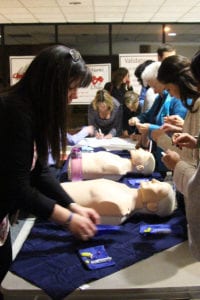By Giselle Barkley
Parents and students alike walked out of Mount Sinai High School knowing the ugly truth about heroin and opioid use and addiction. But they also walked away with a lesson about Narcan.

The school district held it’s first “The Ugly Truth” presentation on Tuesday in the Mount Sinai High School auditorium. Suffolk County Police Department officer George Lynagh, EMS officer Jason Byron and county Medical Examiner Michael Caplan tackled the origins of heroin and trends among addicts over the years. Suffolk County Legislator Sarah Anker (D-Mount Sinai) and Town of Brookhaven Councilwoman Jane Bonner (C-Rocky Point) also spoke at the event.
But residents didn’t simply learn about heroin on the Island, they also left with their own Narcan kits after Byron led a Narcan training class. According to Sgt. Kathleen Kenneally of the police department’s Community Response Bureau, Narcan, also known as Naloxone, was successfully administered around 530 times since the opiate antidote was introduced to the police department in July 2012.
Narcan, which reverses the effect of heroin or other opiate-based overdoses, can be administered via an injection or nasal spray. Mount Sinai resident Susan Matias said the spray is a friendly option for community members.
“Here, it’s introduced through the nasal passages — there’s no harm done, you’re not afraid of administering a needle and/or sticking yourself in the moment of chaos,” Matias said. “I think that’s why people are more open to partake and participate in the training.”
The nasal spray also makes it easier for people who still have a stigma about drug addicts and users. Byron reminded residents that the face of addicts has evolved and they’re not the only ones in need of drugs like Narcan.
“Sadly, the connotation is, we think people that could have overdosed are dirty when really it doesn’t have to be,” Byron said. “For opiate overdose, it doesn’t mean that it’s someone addicted to heroin. It could be somebody who’s possibly on pain management for cancer, end of life care, hospice care. It’s not the stereotypical — I hate to say it — junkie. That’s not what we’re seeing out there.”
According to Caplan, in the last few years, drug addicts who’ve overdosed on the substance have gotten younger and younger. The rate of opiate overdose deaths has increased by 140 percent since 2000. Synthetic opioids, like fentanyl, are responsible for 80 percent of these death rate increases.
Fentanyl, which some dealers or users will mix with another drug like heroin, is 50 times more potent than heroin and 100 times more potent than morphine. Combining this drug with others can make it difficult when administering Narcan.
“One of the problems with Fentanyl is, because it’s so potent, because it acts so fast, you may need to give multiple doses of Naloxone,” Caplan said.
According to Lynagh, the police department is starting to see higher levels of Fentanyl. He added that in his more than three decades as a police officer, the drug is one of the more addictive drugs he has seen. Lynagh added that heroin was initially introduced to combat morphine addiction.
“We don’t have too many people addicted to morphine now,” Lynagh said. “We have this heroin addiction, so sometimes we mean to do something well or combat a drug or something bad, with something else that’s bad.”






